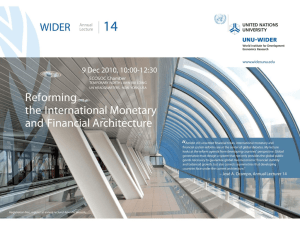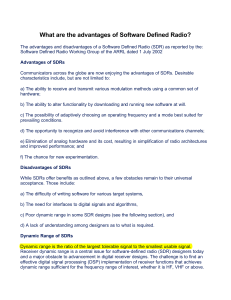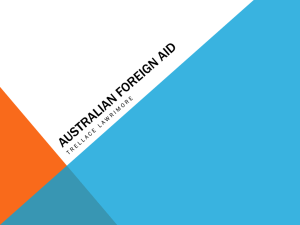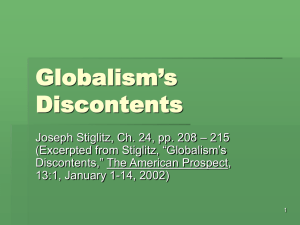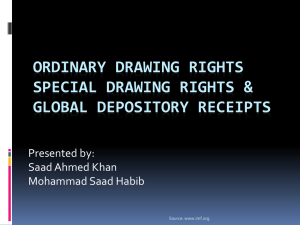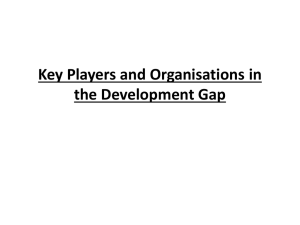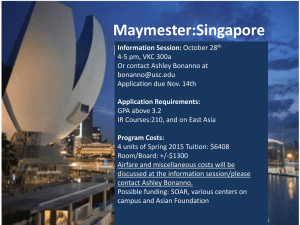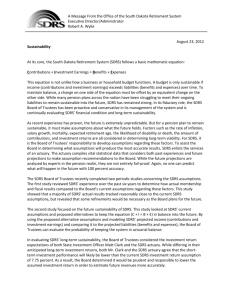Reforming The International Monetary Non-System
advertisement
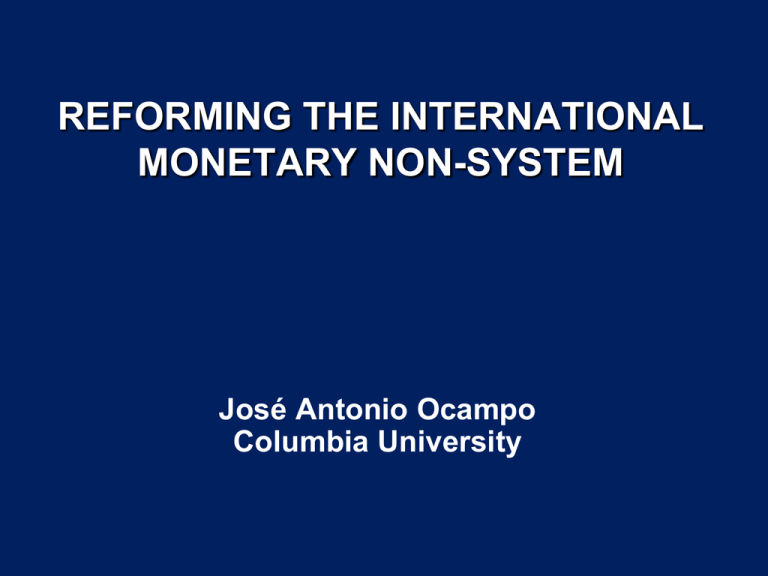
REFORMING THE INTERNATIONAL MONETARY NON-SYSTEM José Antonio Ocampo Columbia University THE CONTEXT TWO ESSENTIAL OBJECTIVES Macroeconomic stability: coherence of policies that are designed at the national level (regional in the case of monetary policy in the euro area), and adequate supply of liquidity at the international level. Financial stability: coherent financial regulation worldwide [an issue that only became important since the 1970s], and debt workout mechanisms [still not fully recognized] THE BRETTON WOODS ARRANGEMENT Global reserve system based on a dual gold-dollar standard (gold exchange standard). Fixed exchange rates, but adjustable under “fundamental disequilibrium” Controls on capital flows, to insulate from speculative capital flows. Official balance of payments support, financed by quotas and (later) “arrangements to borrow”. Limited, to finance current account deficits. Monitoring of member countries’ policies (Article IV consultations), but weak vis-à-vis major countries, and no macroeconomic policy coordination. THE POST-1971 “NON-SYSTEM” Global reserve system essentially based on an inconvertible (fiduciary) dollar. Countries can choose their exchange rate regime, so long as they avoid “manipulation”. A significant degree of capital account liberalization. Official balance of payments: increasingly small relative to magnitude of crises + increasing conditionality in 1980s and 1990s. Ineffective surveillance, and limited macroeconomic policy coordination outside the IMF (G-7, now G-20). THE DOLLAR REMAINS THE DOMINANT CURRENCY… Currency composition of allocated reserves 100% 90% 80% 70% 60% Others Pounds 50% 40% Yen Euros Dolars 30% 20% 10% 0% 1998 1999 2000 2001 2002 2003 2004 2005 2006 2007 2008 2009 2010 2011 … MAJOR CHANGES HAVE BEEN ASSOCIATED WITH THE STRENGTENING OF THE EURO 1.3 74.0% 1.2 72.0% 1.1 70.0% 1 68.0% 0.9 66.0% 0.8 64.0% 0.7 62.0% 0.6 60.0% I III I III I III I III I III I III I III I III I III I III I III I III I III I 1999 2000 2001 2002 2003 2004 2005 2006 2007 2008 2009 2010 2011 2012 US-Euro exchange rate Share of dollars in reseves “ELITE MULTILATERALISM” TO MANAGE MACROECONOMIC COOPERATION “Dollar shortage”: Marshall Plan + European Payments Union. Europe returns to current account convertibility in 1958, but eliminates capital controls only in 1990. Collapse of the dual gold-dollar system: 1971 “Smithonian Agreement” among G-10 to allow for flexible exchange rates. New global imbalances of the 1980s: Plaza Accord 1985, Louvre 1987. Europe: attempt to maintain some exchange rate stability among European countries (the “snake”, the European Monetary System, the euro in Dec. 1995 after the 1992 crisis, finally launched in 1999). THE AGENDA: COMPREHENSIVE YET EVOLUTIONARY REFORM THE FIVE ESSENTIAL ELEMENTS OF A DESIRABLE ARCHITECTURE 1. An international monetary system that contributes to the stability of the global economy and is considered as fair by all parties. 2. Consistency of national economic policies (particularly of major economies) + avoid negative spillovers on other countries (particularly through exchange rates). 3. Regulation of domestic and international finance to avoid excessive risk accumulation, and to moderate the pro-cyclical behavior of markets. 4. Larger emergency financing during crises. 5. [International debt workout mechanisms to manage problems of over-indebtedness.] A REFORMED IMF SHOULD BE AT THE CENTER OF GLOBAL MACROECONOMIC POLICY The best precedent: the debate and adoption of SDRs in the 1960s. 2006: Multilateral surveillance of global imbalances. Since 2009: IMF assists the country-led, consultative Mutual Assessment Process of the G-20… … and broader revival of the IMF: Revamping and large use of lending facilities Strengthened surveillance: multilateral, of major economies, spillover reports. 2009 issuance of SDRs for $283b and bilateral lines. 2010: doubling of quotas. “Elite multilateralism” must be replaced by IMFcentered macroeconomic policy consultation. THE GLOBAL RESERVE SYSTEM: The problems 1. Anti-Keynesian bias: burden of adjustment falls on deficit countries. 2. Triffin dilemma: problems associated with the use of national currency as international currency (can generate inflationary and deflationary biases). 3. Growing inequities associated with demand for reserves by developing countries (selfprotection) + fallacy of composition effect (instability-inequity link) 4. Re-cycling of oil (and mineral) countries’ surpluses ASYMMETRIC BURDEN OF ADJUSTMENT: THE EUROZONE CASE Current account balances of Eurozone countries (% of GDP) 10.0 5.0 Germany Netherlands France 0.0 Italy 2007 2008 2009 2010 2011 2012 Ireland Spain -5.0 Portugal Greece -10.0 -15.0 U.S. DEFICITS AND INSTABILITY OF THE VALUE OF THE DOLLAR U.S. current account and real exchange rate 1.0% 130.0 0.0% 120.0 -1.0% 110.0 -2.0% 100.0 -3.0% 90.0 -4.0% 80.0 -5.0% 70.0 -6.0% 60.0 Current account balance, % of GDP (left) Real exchange rate, 2000=100 (right) GROWING DEMAND FOR FOREIGN EXCHANGE RESERVES BY DEVELOPING COUNTRIES Foreign exchange reserves (% of GDP) (left scale except China and Gulf countries) 25% 127% 60% High income core OECD, excluding Japan Japan Middle income, excluding China 20% 50% Low income Gulf countries China 40% 15% 30% 10% 20% 5% 10% 2010 2008 2006 2004 2002 2000 1998 1996 1994 1992 1990 1988 1986 1984 1982 0% 1980 0% CHANGING COMPOSITION OF GLOBAL IMBALANCES Current account imbalances (billion dollars) 600 400 European Union 200 China Japan 0 1990 1991 1992 1993 1994 1995 1996 1997 1998 1999 2000 2001 2002 2003 2004 2005 2006 2007 2008 2009 2010 2011 2012 USA Oil exporters -200 East Asia emerging Other emerging -400 -600 -800 THE GLOBAL RESERVE SYSTEM: Two alternative routes (which may be complementary) Multi-currency standard Would not be unstable as past systems of its kind (thanks to flexible exchange rates) Provides diversification But new instabilities and equally inequitable An SDR-based system Counter-cyclical provision or SDRs equivalent in long-term to demand for reserves. IMF lending in SDRs: either keeping unused SDRs as deposits, or Polak alternative THE GLOBAL RESERVE SYSTEM: Development issues Three alternatives Asymmetric issue of SDRs (taking into account the demand for reserves) “Development link” in SDR allocation Encourage regional reserve funds, making contribution to the funds equivalent to IMF quotas for SDR allocations. DEVELOPING COUNTRIES GET LESS THAN ONE-THIRD OF SDR ALLOCATIONS SDR ALLOCATIONS BY LEVEL OF DEVELOPMENT 1970-72 1979-81 2009 High income: OECD 73.8% 66.2% 62.9% United States 24.8% 21.7% 16.7% Other 49.0% 44.5% 46.3% High income: nonOECD 0.4% 3.0% 5.9% Gulf countries 0.0% 2.4% 4.8% Excluding Gulf countries 0.4% 0.6% 1.1% Middle income 23.2% 28.0% 29.2% China 0.0% 2.0% 3.7% Excluding China 23.2% 26.0% 25.5% Low income 2.5% 2.8% 2.0% THE “MARKET” FOR SDRs IS ACTIVE BUT SMALL Total Net Drawings of SDRs (in millions of SDRs) 12,000 10,000 8,000 6,000 4,000 2,000 2009 2006 2003 2000 1997 1994 1991 1988 1985 1982 1979 1976 1973 1970 0 THE EXCHANGE RATE SYSTEM The collapse of the original Bretton Woods arrangements led to a “non-system” of exchange arrangements: freedom to choose regime so long as countries avoid exchange rate “manipulation” and large misalignment. This system does not contribute to correcting global imbalances… … and is dysfunctional for orderly international trade. So, need for major reforms: “Indicative” current account objectives “Target zones” or “reference rates” to avoid excessive exchange rate volatility. -5.0% -10.0% -15.0% 7/2/2012 7/2/2011 7/2/2010 7/2/2009 7/2/2008 7/2/2007 7/2/2006 7/2/2005 7/2/2004 7/2/2003 7/2/2002 7/2/2001 7/2/2000 7/2/1999 7/2/1998 7/2/1997 7/2/1996 7/2/1995 7/2/1994 7/2/1993 7/2/1992 7/2/1991 7/2/1990 EXCHANGE RATE INSTABILITY: THE EURO-DOLLAR EXCHANGE RATE Deviation from 12 months moving averagee 15.0% 10.0% 5.0% 0.0% CAPITAL ACCOUNT REGULATIONS Regulation of cross-border capital flows is an essential ingredient of global financial regulation, but this has not been fully recognized. It should be seen as an essential element of macroeconomic management in emerging economies, not as a “last instance intervention” The major problem today is the management of the asymmetric monetary policies that the world requires today (to avoid “currency war”) So long as source countries are not active participants, there is no room for global rules. EMERGENCY BALANCE OF PAYMENTS FINANCING Supplemental Reserve Facility in 1997. Contingency credit line in 1999, eliminated in 2003. Major reforms of 2009 and 2010: Doubling existing facilities. Contingency credit lines: Flexible Credit Line and Precautionary Credit Line. Flexible framework of lending to low-income countries No structural benchmarks. Major problems that remain: Stigma associated with IMF borrowing: need for a totally unconditional credit line. Using SDRs as the major mechanism of financing. GOVERNANCE STRUCTURES: BUILDING AN INCLUSIVE ARCHITECTURE THREE COMPLEMENTARY INSTITUTIONAL ISSUES Reforming the Bretton Woods Institutions A representative organization at the apex of the system A denser, multi-layered architecture Two forces for reform: Inclusiveness can be effective Rising powers demand a place on the table REFORMING THE BRETTON WOODS INSTITUTIONS Quotas and voting power: Over-representation of Europe, underrepresentation of Asia. All seats must be elected. Other institutional issues: Reform 85% majority rule in the IMF. Competitive, merit-based election of the IMF Managing Director and the World Bank President. Clear division of labor between Ministerial meeting, Boards and Administration. THE IMF QUOTA REFORM: SIGNIFICANT REDISTRIBUTION Redistribution of quotas 5.0 3.9 4.0 3.9 3.4 3.0 2.0 1.0 0.3 0.0 -3.0 -4.0 -5.0 -3.9 -3.4 -4.2 -0.3 LI Cs Re st pi ng Ch O in th a er w in ne rs -2.0 De ve lo Ad va nc Un ed ite d St Eu at es ro pe an G -1 0 -1.0 O th er 0.0 THE IMF VOICE REFORM: SLIGHTLY MORE AMBITIOUS Redistribution of votes 5.3 6.0 4.0 3.1 3.6 2.0 0.5 0.0 -6.0 -5.3 -4.8 -1.4 LI Cs Re st Ch O in th a er w in ne rs -4.0 pi ng -2.0 De ve lo Ad va nc Un ed ite d St Eu at es ro pe an G -1 0 -0.5 O th er 0.0 THE APEX INSTITUTION “Elite multilateralism” (the G-20): advantages and concerns: Most positive features: leadership, ownership. Effectiveness: in financial reform, only initially in macroeconomics, problematic mission creep. Most negative: it is a self-appointed, ad-hoc body, with problems of representation and legitimacy. Awkward relation with existing broad-based multilateral institutions. Lack of a permanent secretariat. Desirable evolution towards a decision making body of the UN system, based on constituencies (Global Economic Coordination Council proposed by the Stiglitz Commission). A MULTI-LAYERED ARCHITECTURE Globalization is also a world of “open regionalism”: trade, macro linkages, regional public goods. Complementary role of regional institutions in a heterogeneous international community. Competition in the prevision of services to small and medium-sized countries The “federalist” argument: greater sense of ownership of regional institutions. So, need for multilayered architecture made up of networks of global and regional institutions, as already recognized in multilateral development banks. The IMF of the future as the apex of a network of regional reserve funds. CONCLUSIONS CONCLUSIONS Comprehensive yet evolutionary reform: An IMF-centered macroeconomic policy consultation/coordination. An SDR-based global reserve system. Rebuilding the exchange rate system. Broader use of capital account regulations. An international debt workout mechanism An inclusive architecture: Reform of the Bretton Woods institutions From “elite multilateralism” to a UN-system organization. A multilayered architecture with active participation of regional institutions REFORMING THE INTERNATIONAL MONETARY NON-SYSTEM José Antonio Ocampo Columbia University
